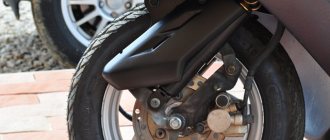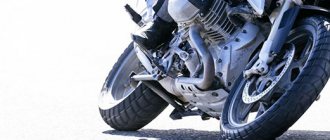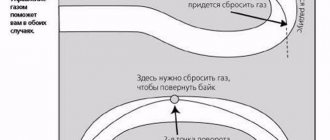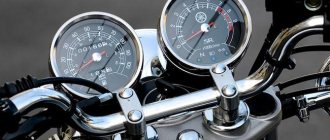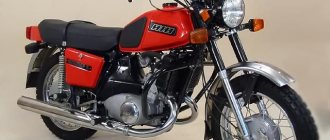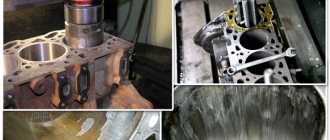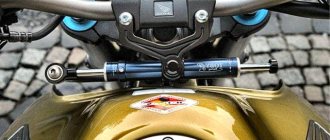17.12.2019
| (Votes: 1, Rating: 5) |
Issues discussed in the material:
- What do yellow dots on tires mean?
- What do red dots on tires mean?
- What do the different colored dots on tires mean?
- What other designations are put on tires?
- How do points on tires relate to their quality?
Every motorist has bought new tires at some point. Questions often arise about the colored dots placed on the surface of the tires. Many people do not know what the dot on the tire means. The Internet is rich in a variety of interpretations of these labels. Some consider these signs to be technological, while others argue that this designates low-grade products rejected by quality control at the factory.
What do yellow dots or triangles on tires mean?
A yellow marker in the shape of a triangle or spot with a diameter of 5 to 10 millimeters on the sidewall of the tire is used to indicate the lightest spot. To determine this area, the tire is balanced at the factory. What does the yellow dot on the tire mean for consumers?
The yellow mark should be used like this: place this part of the tire opposite the letter “L” on the rim. This letter marks the lightest part of the rim. If there is no such mark, then the yellow icon is combined with a nipple or valve for pumping. As a result, the wheel is as balanced as possible. As a result, fewer compensators are required during balancing. However, it should be understood that the difference in weight of different sectors of the wheel is quite small. Therefore, during the operation of the tire, the yellow dot quickly loses its purpose. It is absolutely not needed at the next tire fitting.
How to ensure maximum accuracy in your wheel balancing procedure
About the design and operation of a car. What is the difference between 92 gasoline and 95. Compression ratio and a modern car. From a technical point of view
1) Rotation speed.
Modern machines have several fixed rotation speeds - from 150 to 400 rpm. Along with an increase in this indicator, the accuracy of wheel balancing improves: the machine becomes more susceptible to imbalance.
2) Balancing accuracy.
It is adjusted according to a special equipment scale, ranging from one to twenty or more grams. In other words, if the balancing accuracy is set to 20 g, then the equipment will not take into account an imbalance of 19 g. And this is already a significant deviation from the norm, accompanied by a beating of the steering wheel.
3. Number of wheel starts.
To eliminate the imbalance, special weights are installed. The craftsmen determine the location and weight of the weights in stages, making step-by-step starts of the wheel. The more test runs are made, the more accurately the installation location and weight of the weights will be determined.
4) It is necessary to ensure that the axis of the wheel mounting on the machine coincides with its actual axis of rotation.
To do this, you need to mount the wheel on the machine using the disk mounting holes. The exception is Citroen cars, where the central hole of the disc is used for alignment.
5) Carrying out final balancing.
This procedure is very important for high-speed cars. Final balancing involves adjustment after mounting the wheel on the hub, at a rotation speed of 1000 rpm. Using Haweka adapters eliminates the need for final balancing.
6) Pre-wash wheels.
High-quality automatic washing is carried out, often using cleaning granules. Manual cleaning of wheels is undesirable: small particles of dirt and stones stuck in the tread will negatively affect the accuracy of the procedure.
Note: the large error of the machines simplifies the work of unscrupulous craftsmen - wheel balancing is carried out quickly, although the result obtained is almost zero. In case of claims from the car owner, would-be craftsmen rely on the poor condition of the roads.
Benefits of proper wheel balancing
1. Comfortable, safe ride. Predicted behavior of a car on the road.
2. Extension of tire service life - from 25%.
3. Fuel economy - about 12%.
4. Preservation of suspension. This guarantees reduced running gear maintenance costs.
Technology violations
The weight of nearby weights should not exceed 60 g. Exceeding the declared value indicates incorrect assembly of the wheel: the valve does not coincide with the yellow mark on the tire. But this is far from the only mistake that amateurs make when balancing wheels.
Other errors:
- Balancing tires or wheels covered in mud. In a good service, the wheels are always thoroughly washed, removing the previously installed compensating weights.
- A dirty, dusty machine is being used.
- Lack of special lubricant on the disk sides. Because of this, the tires do not fit correctly onto the disc. Tire fitters rely on the quality of the tire, but basic inflation puts everything in its place.
- The colored mark is located far from the nipple, although it should be exactly the opposite.
Remember, proper wheel balancing is the key to your safety on the road. Therefore, use the services of proven, competent specialists. Which service should or should not be used, read the article: “Proper tire fitting - who to trust.”
Thanks for visiting my blog!
I hope that the information was useful to you.
Be sure to watch the video.
What do red dots and triangles on tires mean?
A red dot on a new tire is also common. What does it mean for the user? This is the heaviest part of the tire and is also the toughest. Similar to the recommendations for the yellow mark, the red one should be aligned with the letter “L” on the disk, or placed opposite the valve.
Red dots are most often found on tires that are equipped with cars during factory assembly. In this case, the original disks in a certain place are marked with white dots. These two marks must be aligned with each other. However, car owners in normal tire fitting conditions should be guided only by the yellow icons, placing them near the air valve. The red dots are for mounting the tires on the rims during the initial assembly of the car.
Why are there colored stripes on new tires?
The first purchase of new car tires is a responsible and important undertaking for a beginner. The user manual for the car indicates the main parameters of the tires that should be installed on the wheels.
This simplifies the selection and purchase, because the necessary numbers are stamped on the side.
The meaning of the colored dots and stripes on the working part is unclear and causes fantastic and absurd rumors among motorists.
What do the colored stripes mean?
For some time now, on new tires you can see colored stripes of white, blue, red, green, blue or white - two or three. They can be carried directly along the tread or in the groove. They are not a functional element and are not embedded in the rubber, so they soon wear off and become invisible.
In fact, color coding does not provide any useful information to the end user. These tags were invented for the convenience of warehouse workers - quick identification and search for products from different batches. To ensure safety and save space, tires are stored in high stacks stacked sideways on top of each other and the perimeter markings are visible from all sides.
Mystery dots and circles
On the side of new tires you can see bright dots - circles about one centimeter in diameter in red, white or yellow. This type of labeling is also of little use to non-specialists. It is believed that these points indicate the heaviest and lightest parts of the tire. This information is intended to speed up wheel balancing by setting approximate initial parameters.
Although the tires have factory balancing marks, the wheel rims do not always correspond to the ideal recommended parameters, so for high-quality wheel balancing it is better to go to a tire shop, where they will be checked using special equipment.
Don't be intimidated by the color markings on car tires. The only reliable information that a buyer can extract from it is that it is truly new.
It is better to pay attention to finding a truly reliable seller and studying the assortment, choosing tires that suit the weather conditions and the quality of the road surface in your area
What does the white stamp with a number on tires mean?
Tires are also sometimes marked with a white mark. It can be a square, rhombus, circle or triangle. There is a number printed inside. This emblem is an analogue of the Soviet quality mark. A tire marked in this way has been precisely subjected to final quality control at the factory. Consequently, its operating parameters are within the values set by the manufacturer. Also, using this mark, you can identify the specific employee who carried out the quality control procedure for this tire.
Colored spots on the side surface
On the sidewalls of the tire, in addition to the logo with the name of the manufacturer, the rubber model and its parameters, you can see colored marks in the form of round, square and triangular spots. The label can be either one or several symbols of different colors.
The most common designation that can be found in auto shops and warehouses is a round spot of red, yellow and white. This designation is applied during the initial balancing of tires by the manufacturer and is intended for the tire service worker so that he can correctly fit the tire on the wheel rim. There is no difference in whether the spot is round or triangular in shape. The color of the spot itself plays an important role.
The red spots indicate the heaviest point of the tire where maximum radial force deflection occurs. The very concept of “radial force” is used in calculating the dynamic and mechanical properties of a tire, to produce the highest quality and uniform tires. As you know, a tire is a technically complex product consisting of many different layers of rubber. And the radial force, in turn, shows with what force elastic elements of different stiffness are compressed and repelled during tire rotation.
On some rims you can find the designation “L”, which indicates its lightest point. In addition to the letter "L", it can be a colored dot. Using these designations, a tire shop worker is guided when installing a tire on a rim. When the disk does not have marks, you need to navigate by the nipple. In the case of a red dot on the sidewall, it should coincide with the designation of the light point of the disk, or if the disk does not have designations, it should be opposite the nipple. Typically, such red dots can be found on tires that come with a new car.
The yellow dots on the tires indicate the lightest and weakest point. When installing a tire, the yellow mark is located opposite the weak point mark of the wheel rim or opposite the valve when it is missing. With this arrangement, as a result of heavy loads, the disk and tire will be maximally protected from damage, and the impact will be less transmitted to the suspension.
The white dot indicates that the area where it is applied is the most flexible and the radial force deflection is minimal. In the same case as with the yellow spot, the white dot should be located opposite the wheel rim mark or coincide with the nipple.
In addition, you can find similar green or blue dots on tires. They must correspond to the red and yellow designations, but in any case, universally approved colors must be used to indicate tire parameters. This is usually the work of manufacturers who want to confuse their customers by making smart advertising moves to satisfy their personal gain. Therefore, before purchasing, you should definitely consult the seller and ask him to explain the meaning of each mark.
What does a white circle or dot on tires mean?
Among tire manufacturers, there is a practice of marking products with white dots. Let's figure out what this white dot on the tire means and how to follow this symbol. In this way, the place where the deviation of the radial force is minimal is marked. In fact, this is the most flexible part of the tire. During installation, this mark is positioned opposite the “L” mark on the disk. If this letter is missing, the white circle is combined with the top mark.
What are they for?
First of all, such signs appear in the form of balancing marks, which are necessary in order to carry out the most accurate balancing of the tire with the disk. In addition, what the color marks on tires mean is indicated in the documents defining the methods of production, subsequent marking and use of tires in Russia. However, due to the fact that the GOST regulating this was introduced back in 1984, it does not contain any mention of the colors of such designations.
Often, modern markings used on car tires are small round dots. Typically, the size of such designations is 10-15 mm in diameter. If previously the markings had a triangular shape, today they are predominantly round. But the main differences are now considered to be the different colors used for the designations. The main ones are:
- Yellow.
- Red.
- White.
Colored stripes on the tire
There are even letter designations, as well as various stripes. It is worth examining each of the options in more detail.
Yellow
When such a stamp is applied to the side surface of the tire, this indicates the lightest and also weakest coating in this place, from the point of view of protection. This parameter is easily identified even during static balancing. In addition, such designations are also applied to wheel rims, only in the form of the “L” symbol. Therefore, when beading the wheel, it is recommended to place them in such a way that similar markings on the two elements are in opposite directions. This is required so that in the event of heavy loads due to a collision with an obstacle, there is no damage to two elements at the same time.
Red
A feature of such designations is considered to be an indication of the strongest and most durable place on the tire. In professional parlance, it is called the point where the maximum deflection of the radial force occurs. Red dots are usually installed on new tire models that have not yet been used. Often they try to install it when beading the wheel, flush with the “L” symbol marked on the disk.
White
In this case, the marking indicates the most flexible place that the tire has. In other words, the white dot, which may be completely colored or has dotted edges, indicates the place on the tire where the least radial force deflection occurs. Similar to the yellow designation, it is recommended to install it as far away from the “L” designation on the wheel rim as possible.
Points on the wheel
Colored stripes
Separately, it is worth mentioning the colored stripes on the tire tread. Long lines are usually present on the entire rim of a car tire. Usually they are applied to the protectors or between them in special grooves. But only the manufacturer needs such tags. They are used to identify the storage index. It has a specific tire that is located for a certain time in the territory of a large warehouse. Simply put, they are used in the form of a kind of barcode, through which the search for the product of interest is carried out. In this case, products are differentiated by color, as well as the thickness of the applied lines. They indicate belonging to a specific batch produced in a certain period.
Numbers
Such markings, applied to the surface of car tires, differ solely in their nominal value. In this case, color or thickness does not play a role, but only actual designations. They indicate the level of inspection that the material (rubber) from which the tire was made was subjected to. By and large, it represents a kind of GOST. The presence of such markings on the surface of the product indicates that the finished product has previously passed a quality test.
Marks are applied to tires in the form of digital values inside a circle. At the same time, they indicate the license plate number of the inspector who carried out the verification process itself, and therefore such information does not provide any benefit to the consumer. If a defect is identified, the designations will help you find the person responsible in production for putting such a product on sale.
The main useful information for motorists is provided exclusively by colored dots applied to the surface of finished products. All other designations are needed only for manufacturers, since they contain internal information about the production and testing of finished products.
What do the digital marks on tires mean?
In all of the above cases, the color of the mark played an important role and carried a certain semantic load. However, there are other symbols on tires. The numbers in the circle, regardless of color, indicate the number of the inspector who carried out quality control of the product at the factory. Here the number, not the color, is decisive. Tires with this marking have passed all the necessary tests to ensure the quality of the product.
We recommend
“Winter tires 255 R18: manufacturers, advantages, disadvantages” More
Russian tire products can be equipped with the inscriptions “TK” or “OTK”, enclosed in a green, white or yellow square. However, not all tires have this marking. Often European and Japanese manufacturers do not put such stamps on their tires.
What does the marking say?
If you take a car spring, you will notice that different products may have different colors with which they are marked.
All marks are often colored. The following shades are used:
- yellow;
- orange;
- blue paint;
- brown;
- orange;
- green;
- pink;
- black;
- white.
Moreover, the last two colors are found mainly not as a method of marking, but simply as the color basis of the product itself.
Differences in color make it possible to determine the degree of hardness relevant for a particular sample as simply and clearly as possible. Special tests are carried out at factories. The springs are compressed with a regulated force and the height is measured. If a part does not meet the specified parameters, it is rejected.
All designs that have successfully passed tests receive class A or B. Class A is relevant for springs that fall within the upper tolerance range, that is, hard ones, and class B for softer ones. The height of the latter corresponds to the lower tolerance zone.
In addition to color, an important indicator of an autospring is the diameter of the structure. It is determined not by the manufacturer himself, but by the car company that designs the car model. The executor of orders for the release of springs cannot independently make any changes. All parameters are calculated and verified in advance. This will allow the car to further meet the automaker’s promises in terms of comfort, safety, ground clearance and other indicators to which springs are directly related.
The abundance of flowers should not confuse motorists. This is especially true for owners of VAZ products. In this case, class A includes white, yellow, orange and brown marks. If the mark is black, blue or cyan, then it is class B.
I briefly explained the essence of the marks. The values of the marks in kilograms and millimeters during compression and stretching, as well as their combinations for different cars may differ from each other. Here you need to specifically look at the specifications for your car. Unfortunately, you can’t tell about all the cars in one article. But in general it should be clear.
What do the longitudinal lines on the tire tread mean?
Many people misinterpret the purpose of the multi-colored longitudinal stripes on the tread. Some believe this is a wear indicator. Others argue that this is an indicator of lateral rolling. In reality, everything is much simpler - with the help of these lines, manufacturers mark individual batches of tires. Thanks to these insignia, it is much easier to sort products in the huge warehouses of tire factories.
These lines are located both on the outer part of the tread and in its grooves, as well as on the rim of the tires. There are a variety of color combinations of lines. The thickness and set of colors in one line also differ. Thus, the manufacturer encoded information about the diameter and size of the tire, as well as its seasonal purpose. When choosing and purchasing tires, there is little point in looking closely at these stripes. The only thing that a buyer can determine from them is the complete identity of the tires by comparing the markings on a set of tires.
A situation often occurs when you buy a set of tires: three from one batch and one from another. Despite the same tread pattern, tires from different batches may differ in weight. A difference in tire weight of even 10–20 grams affects the driving characteristics of the car.
You need to understand that a mark applied with paint cannot serve for a long time during the operation of the tires. Therefore, the information carried by such designations is used only before installing the tires on the rim.
Why are they color coded?
Markings using colored traces of paint are designed to simplify the process of selecting products for motorists. Moreover, the marks are put on just like that. This is the result of a complex and lengthy production process.
The production of springs for cars involves various technologically complex operations. Not all of them can be controlled. Some of them are even impossible to follow directly until the result is obtained in the form of a finished spring for a vehicle suspension. It is because of this that mass manufacturers of car springs carry out mandatory product testing and comparative analysis. This is not just a wish of the manufacturer, but an emerging necessity.
Thus, a classification by color arose. This is one of the few ways to distinguish elements of different stiffness indicators after their manufacture has been completed. Yes, there are alternative methods, but color is considered the most simple, reliable and informative.
Opinion of car enthusiasts and professionals about dots and marks on tires
- This information is needed only by specialists “The red dot means the hardest part of the tire. This is not the same as the heaviest. If the red and yellow dots are placed next to each other, this is a sure sign of the presence of a tread or carcass seam in this place. To summarize, we can say that these tags are needed only for tire service employees.”
- Unfortunately, theory is very far from practice
“I’ll share my professional experience, because I’ve been working in a tire shop for 9 years. We conducted experiments by assembling a wheel with different tire positions. The goal was to find out exactly what the colored dots on the tires mean. As a result, we came to the conclusion that the marks do not affect the balance of the wheel in any way. Although in theory they should. Therefore, we can say that the manufacturer puts them in any way. The only way to build a perfectly balanced wheel is to use a machine with an optimization function.” - Another option for what dots on tires can represent
: “There is a lot of information on the Internet about why dots are placed on tires. But here are excerpts from the publication “Journal of 1000 Tips”. The red and white marks are the heaviest areas of the tires. But what do the yellow dots on the sidewall of the tire mean? This color is used to mark defective products. One dark evening I bought two tires. Naturally, I didn’t look at them well. The next morning I examined them and found yellow circles that someone had tried to erase with sandpaper. So I started thinking: why did the seller need to remove these marks?” - Why are Russian tires so bad?
“In Russia there are already factories producing tires of such famous brands as Michelin and Nokian. Factories of the Japanese company Yokohama, the German Continental and the Italian Pirelli opened. Bridgestone will launch production very soon. At the same time, Nokian brand products are produced in only two enterprises around the world.
Deep groove and scale
Well, the last thing (though this does not apply to color marks) - many also asked me what is the slot in the tread and next to it a scale from “2 to 7”, now this is on some foreign and Russian tires (for example - VIATTI).
This is a trivial wheel tread meter. If you put a coin into the slot, you will notice that it seems to be rolling from top to bottom. Where the highest part is, the tread height is 7 mm, where 2 mm is the lowest. Thus, you can evaluate the wear, as you can see, nothing complicated. Let me remind you that winter tires (mostly, of course, studs) below 5 mm can no longer be used!
Now let's watch a short video version.
Well, I think I answered your question about color codes. Now this question will no longer arise. Sincerely yours - AUTOBLOGGER
How to choose winter tires for a car: tips and warnings
How and which one to choose winter tires? This question is asked by many car owners before the onset of winter. The cost of a set of winter tires is quite high, but every driver wants the car to have the best grip on the road and to be comfortable driving the car. Therefore, before choosing tires, understand this issue. How to determine whether it is with or without spikes? Should I take wide or narrow tires? Should I buy symmetrical, asymmetrical or directional tires? To make the right choice, follow these steps:
- You need to understand which type of tires is best suited to the type of climate in which you live: Scandinavian or European.
- Then decide on the manufacturer: branded wheels from Michelin, Pirelli, Bridgestone? Or well-proven tires in the mid-price segment Firestone, Kleber, Toyo? Budget Rosava? Do you drive a lot? Then you should buy the best quality tires.
- Decide how new the model should be. Compared to classic options, ultra-modern ones will cost much more. You can safely choose last year's models. But there is one drawback: there is a possibility that such tires are no longer produced, so replacing them will not be easy.
- Select specification. To do this, we look at what size and type of tires are suitable for your car model. You can find this information in the service book. You should purchase tires of the size that can be used on your car. With such wheels, driving a car will be as safe as possible.
- Select a tread pattern. It all depends on the conditions in which the car is operated. During the winter season, do you drive in the city on clean roads? Then the protector can be made in the form of small checkers. If you plan to drive on a snowy road, then the tread pattern should be aggressive.
- Compare speed indexes. As the index increases, the permeability of wheels on snow decreases. This principle works vice versa. If you plan to drive on dry asphalt in winter, then it is better to choose tires with a high speed index, because the braking distance will be shorter.
- Choose where to buy branded tires. The seller must be reliable so that you do not buy a fake.
- Conduct a visual inspection of the wheels. You can test the tires. It is clear that you will not be allowed to put a set of wheels on your car and drive it. What to do? We take a cloth glove with us. We run it in the direction of the tread pattern. Does the glove slip? This means the grip will be the best.
- Check the softness of the tires. We feel them: if the rubber bends, it means that the tires will remain soft even in severe frost.
- Find out the expiration date of the wheels. The specified date must be no more than 2 years. If the tires are already 3-4 years old, their quality may deteriorate. The date of manufacture is indicated on the side of the wheel.
- Study the labeling and ask the seller to provide a certificate of conformity. This document is proof that this type of tire can be used in our country.
How to choose winter tires to save money if your budget is limited? The best solution is to purchase a different tire size. You should follow the manufacturer's recommendations, but some exceptions can be made. The larger the profile size and the seat diameter, the more expensive the tires.
You can also choose winter tires with a lower speed index, then the price for a set of wheels will decrease significantly. For example, your car cannot go faster than 150 km/h. This means that you don’t need to buy wheels with a speed index greater than “P”.
In an effort to save money, one should not forget about quality. It is not recommended to purchase used wheels. Even if visually such tires look normal, the grip on the road will be worse than that of new winter tires. You can only use used tires for 1 season.
You can compromise and choose all-season tires. But this can only be done in European countries where the climate is mild and there are no severe frosts.
You cannot install only 2 winter tires. Can't afford to buy a set of winter wheels? Installing different types of tires is not a solution to this problem. Because driving a car with two summer and two winter wheels can be dangerous.
